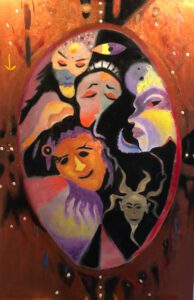 Art, Magic, and the Paranormal
Art, Magic, and the Paranormal
What is art today? There is no definitive answer to the question. Art throughout history has served many needs and purposes–religion, the state, the rich. The twentieth century, with the rise of so called modernism, had the effect of freeing art from all the traditional constraints. Art today is an open universe, a matter of individual creation.
In the radical freedom of today’s artistic enterprise, technology is a great ally. The traditional artist had to rely on patrons, royal or wealthy homes, churches, state rooms and buildings, different kinds of museum, and more recently, galleries where the work is physically anchored and open to the public. Today an artist can create his or her own online gallery to display work to viewers, in principle, all over the planet. Moreover, the viewer, if inclined, can offer comments and engage with the artist.
In some ways, Painting the Paranormal is attuned to traditional memes and themes. Throughout history artists have made works that celebrate archetypal figures and events: heroes, saints, gods and goddesses—miracles and the supernatural. Today we might call these things surreal or paranormal. Regardless of time or place, something in us always hankers for novelty, a new perspective, a moment of transcendence. I believe this is so because part of our subconscious self is already attuned to a greater reality. As the immortal Peggy Lee sang: “Is that all there is?” The message of the creative imagination—of art in all its forms—is “No! There is a great unknown more.”
Laying aside the dead dogmas of religion and science, the strange and the unexpected will go on haunting and teasing us forever. The ‘unknown more’ is our own mind, and not just our surface mind but the part of our minds below the threshold of everyday awareness.
On the other hand, the ‘surface’ mind is no slouch. On the contrary, our everyday mind is pure magic, and a great mystery to science. It is, after all, the launching pad for all our actions and adventures—or miss-adventures. The fact is that my ordinary mind can be the first step in transforming my life.
There are two ways I am given to “painting the paranormal.” One way is to tell a story through an image of something known to be paranormal—or miraculous, if the word doesn’t embarrass or frighten you. It could be an event or a person. So I made a painting of Therese Neumann weeping blood in a state of ecstasy, a well-known figure I discuss in my book on miracles, Smile of the Universe. She was an amazing lady who ate and drank nothing for the last 35 years of her life! She claimed to be nourished by the divine spirit. Not at all emaciated, she was healthy and perfectly functional and sociable—at least when she wasn’t bleeding in ecstasy.
I’ve done paintings of Arigo, a Brazilian healer whose life and abilities were shockingly and incessantly surreal. The paintings Neumann, Arigo and others are meant to serve as pictures of the impossible. Painted images are like drops of eternity; they take something out of time. A painting is a queer object, an image frozen in the timeless.
And there’s a second sense in which I paint the paranormal. As I see it, the act of painting is itself a form of materialization. Let’s say I begin by sketching in light pencil three wavy lines diagonally on a piece of stretched canvas. I have no idea where the impulse came from nor the impulses that follow. Producing the entire painting from first to last comes from my subconscious. And that’s the fun of it. I never know what’s next, but bit by bit it all comes together.
Science has no idea how it is possible for our intangible, invisible, nonphysical thoughts and images to drive our bodies so we can paint pictures, make music, dance or play sports. Art is all about magic and the psychokinetic art of living. Imagination is our main weapon in the war against the established realities that are killing us. I’ll be exploring all this here in future and welcome discussion with readers and viewers.
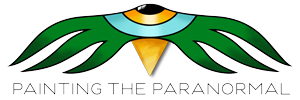
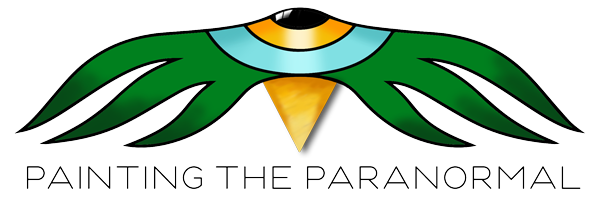
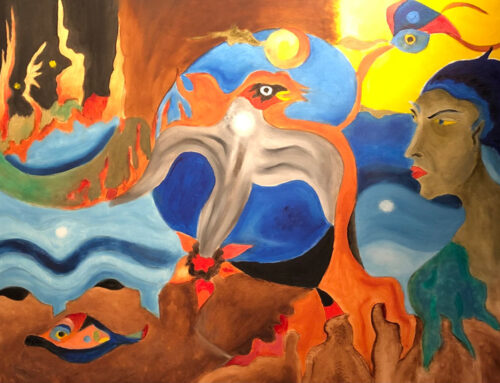
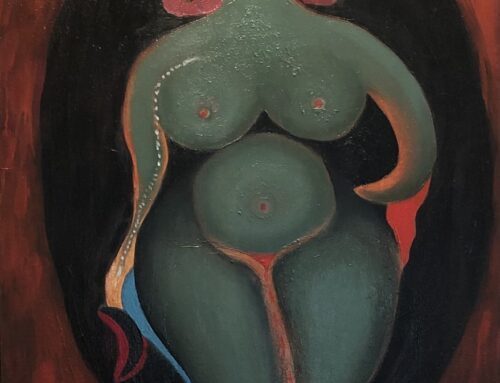
Leave A Comment